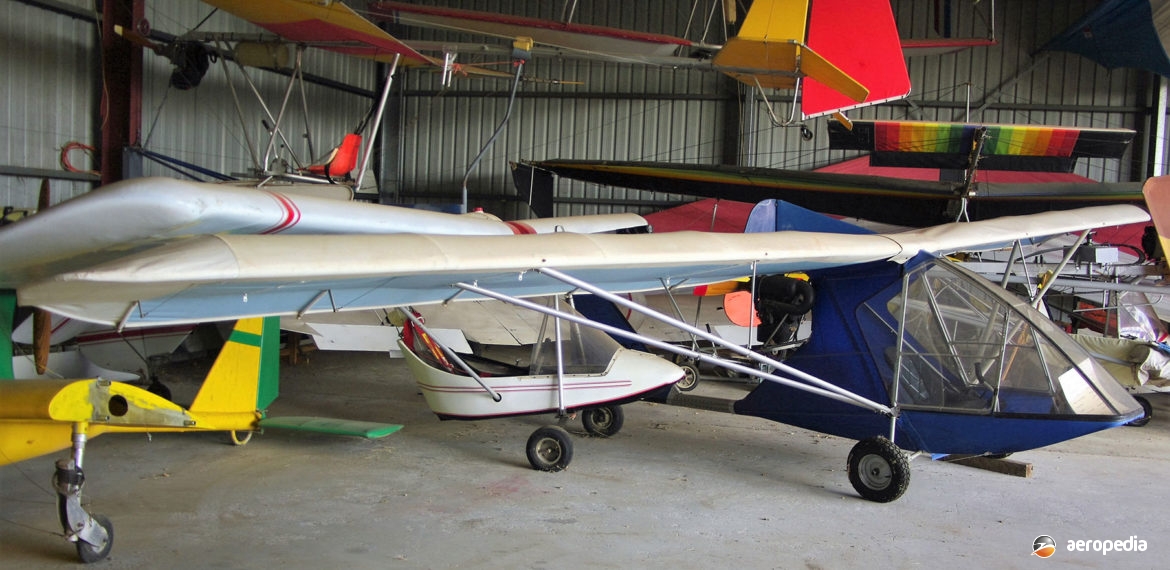Photograph:
Birdman Chinook (unregistered) at Holbrook, NSW in November 2014 (David C Eyre)
Country of origin:
Canada
Description:
Single-seat light sport monoplane
Power Plant:
One 21 kw (28 hp) Rotax 277 single-cylinder, two-stroke, air-cooled engine
Specifications:
- Wingspan: 10.68 m (35 ft)
- Length: 5.34 m (17 ft 6 in)
- Height: 1.78 m (5 ft 10 in)
- Wing area: 13 m² (140 sq ft)
- Never exceed speed: 138 km/h (85 mph)
- Max speed: 97 km/h (60 mph)
- Cruising speed: 81 km/h (50 mph)
- Stalling speed: 39 km/h (24 mph)
- Service ceiling: 4,575 m (15,000 ft)
- Rate of climb: 213 m/min (700 ft/min)
- Load factors: +6/-3G
- Fuel capacity: 19 litres (4.17 Imp gals)
- Empty weight: 113 kg (250 lb)
- Useful load: 170 kg (375 lb)
- Loaded weight: 283 kg (625 lb)
History:
Designed by Vladimir Talanczuk, a Ukrainian-born aeronautical engineer, the Chinook over the years was produced in a number of models, either single-seat or two-seat, and was a high-wing ultralight aircraft, the prototype of which was flown for the first time on 12 December 1982 at Wizard Lake, Alberta and produced by Birdman Enterprises of Alberta, Canada, with more than 1,200 examples delivered.
The first example produced was the WT-11 which was released to the ultralight market in 1983. Aims for the design were good flying characteristics, and simplicity of construction. The design complied with US FAR 103 Ultralight Vehicles Regulations and usually was available with a tailwheel undercarriage but many examples were fitted with floats. Two models of the WT-11 were produced, the WT-11-277 with the Rotax 277 engine, and the WT-11-377 with the Rotax 377 engine.
The aircraft had an enclosed cabin with a high aspect ratio wing giving it the ability to soar and it had good performance on the power available, cruising at 80 km/h (50 mph) using 5.7 litres (1.25 Imp gals) per hour. In 1987 the WT-11 was redesignated the Chinook 1S to indicate the single-seat model, as the Model 2S was later developed, this being a two-seat model.
Construction was of 6061-T6 aluminium tubing covered with aircraft-grade Dacron. The fuselage was built on a 10.16 cm (4 in) tube that supported the cockpit and tail surfaces. The wing had two-spars supported by V-struts and jury struts, and had internal lift and drag bracing wires. The wings of the WT-11 were removable for hangarage and trailering.
Development led to the two-seat Chinook 2S, which continued in production alongside the Chinook 1S, and was usually fitted with the 31 kw (42 hp) Rotax 447 or the 37 kw (50 hp) Rotax 503 engine and differed in having a second seat where the baggage area of the WT-11 was located. It had the fuel tanks moved from the fuselage to aerodynamically-shaped plastic tanks fitted to the wing struts.
Birdman Enterprises ceased production after five years and went out of business in 1987 after approximately 700 aircraft had been delivered, the aircraft kits at that time being produced by Canadian Ultralight Manufacturing at St Paul in Alberta. Later parts for the fleet were produced by Aircraft Sales and Parts (ASAP) in 1988 at Vernon in British Colombia and ASAP later re-designed the aircraft, introducing a new two-seat model in 1989, which became the Chinook Plus 2 which had a new wing of 10 m (32 ft). This model was available for some years and could be fitted with the Rotax 503, HKS-700E, Rotax 582 and the Rotax 912 engines.
A number of examples have been imported to Australasia over the years, one being fitted with amphibious floats. Registrations under RAA Regulations of the WT-11 series included: 10-0003 (c/n 3337 – Rotax 503 engine); 10-0029 (c/n 2967 – Rotax 277 engine); 10-0104 (c/n 2887); 10-0194 (c/n 2437); 10-0114 (c/n 2747 – Rotax 277 engine) in May 1988; 10-0140 (c/n 2927 – Rotax 477 engine); 10-0188 (c/n 2907 – Rotax 277 engine); 10-0194 (c/n 2437 – Rotax 277 engine); 10-0211 (c/n 3357 – Rotax 377 engine); 10-0134 (c/n 2987 – Rotax 277 engine); 10-0136 (c/n 2857 – Rotax 277 engine); 10-0359 (c/n 2837 – Rotax 277 engine); 10-0472 (c/n 2877 – Rotax 477 engine); 10-0526 (c/n 2657 – Rotax 277 engine); 10-0751 (c/n unknown – VW-1600 engine); 10-0937 (c/n 2937 – Rotax 277 engine); 10-1094 (c/n 1747 – Rotax 377 engine); 10-1127; 10-1135 (c/n 2877 – Rotax 277 engine); 10-1138 (c/n unknown – Rotax 447 engine); 10-1207 (c/n 2417 – Rotax 277 engine); 10-1221 (c/n 2667 – Rotax 377 engine); 10-1367 (c/n 1737 – Rotax 277 engine; 10-1792 (c/n 11); 10-3448 (c/n 2757); 10-3958 (c/n 2887); 10-4233 (c/n 3007) and 10-0194 (c/n 0526).
A Birdman Chinook Plus 2 was registered with the RAA as 28-3823 and was fitted with a Rotax 503 engine.

